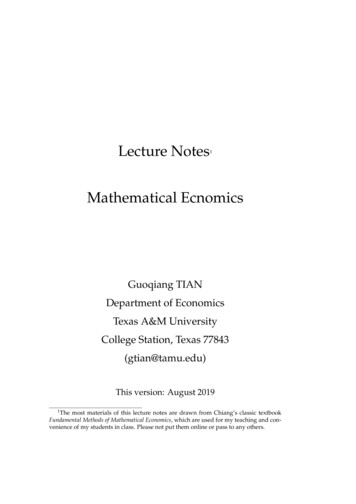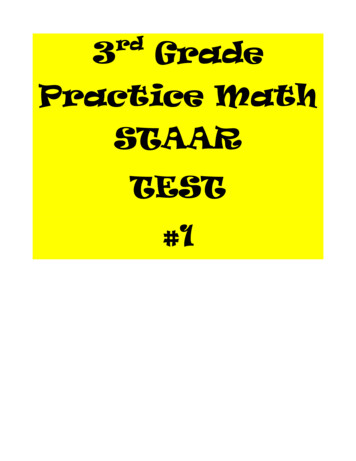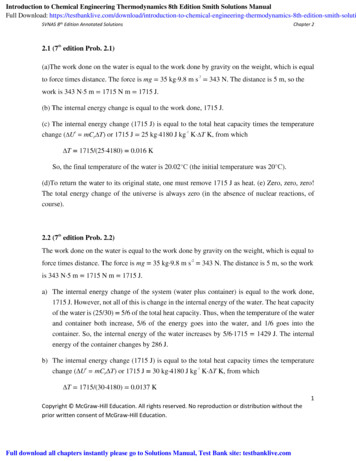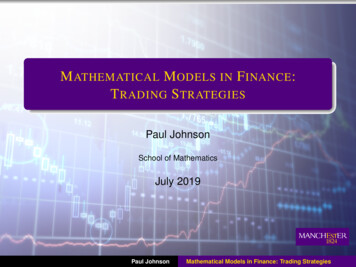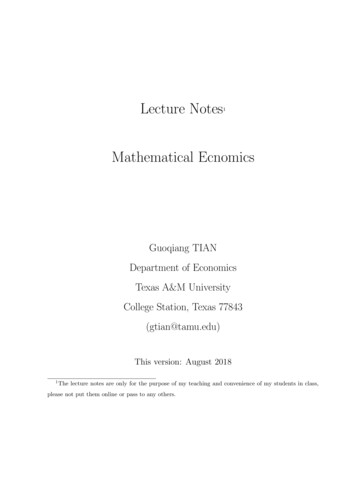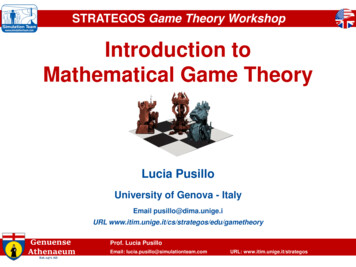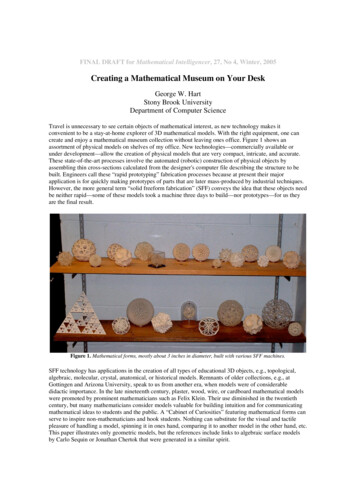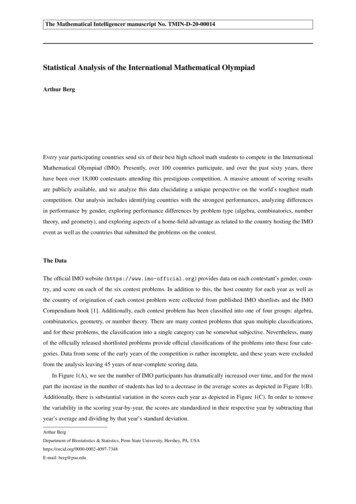
Transcription
A Mathematical ArtJim HenleThe Mathematical IntelligencerISSN 0343-6993Math IntelligencerDOI 10.1007/s00283-019-09874-y1 23
Your article is protected by copyright andall rights are held exclusively by SpringerScience Business Media, LLC, part ofSpringer Nature. This e-offprint is for personaluse only and shall not be self-archived inelectronic repositories. If you wish to selfarchive your article, please use the acceptedmanuscript version for posting on your ownwebsite. You may further deposit the acceptedmanuscript version in any repository,provided it is only made publicly available 12months after official publication or later andprovided acknowledgement is given to theoriginal source of publication and a link isinserted to the published article on Springer'swebsite. The link must be accompanied bythe following text: "The final publication isavailable at link.springer.com”.1 23
Author's personal copyFor Our Mathematical PleasureJim Henle, EditorA Mathematical ArtJIM HENLEThis is a column about the mathematical structures thatA work of art is a CONSTRUCTION called into beingby the artist who . has felt compelled to communicate[his ideas] to his fellow human beings. A researchmathematician plays with ideas, which he puts togetherinto what may vaguely be called STRUCTURES . Inways, possibly quite similar to the ways of the artist, [themathematician] makes CONSTRUCTIONS. In this sensehe is also an artist.give us pleasure. Usefulness is irrelevant. Significance,—Zoltan Dienesdepth, even truth are optional. If something appears inthis column, it’s because it’s intriguing, or lovely, or justfun. Moreover, it is so intended.he words of the pioneering educator, mathematician, philosopher, psychologist, and poet ZoltanDienes (1916–2014) suggest that the focus of thecolumn ‘‘For Our Mathematical Pleasure’’ might be an ART.Is that possible?The beauty of mathematics has been celebrated forthousands of years, but it’s a big step, philosophically, to gofrom ‘‘beautiful’’ to ‘‘art.’’ We’re going to take that step.Outline of the step:T1.2.3.4.5.6.7.8.The chief difficulty in defining the art of mathematicsDefining the art of mathematicsDeciding when a work is goodThe appreciative publicSome important artistsA few masterpiecesConsulting with philosophersConsulting with historiansOn the advice of our legal team (and at the alarmedinsistence of our editor), we include9. DisclaimersTo end, I’ll give you10. A new (possibly) work of art, which will definitelysatisfy point 2. Readers can judge whether it satisfiespoint 3 and whether they belong to 4.This column may be controversial. That would be fun!Please write me at pleasingmath@gmail.com with yourcomments!The Chief DifficultyâJim Henle, Department of Mathematics and Statistics,Burton Hall, Smith College, Northampton,MA 01063, USA.e-mail: pleasingmath@gmail.comThe chief difficulty in locating an art within mathematics isdeciding what the objects of such an art could be. Findingbeautiful specimens is not enough. A sunset, for example,may be stunning, but sunsets appear without humanÓ 2019 Springer Science Business Media, LLC, part of Springer Naturehttps://doi.org/10.1007/s00283-019-09874-y
Author's personal copyagency. An art object should involve the participation of anartist.As a first guess for art object we might consider theorems. But theorems are necessary truths. They’re a bit likesunsets. Humans may discover theorems, but it’s hard tosay that they create them. The theorems were already there;in fact, they existed before the big bang. Discovery doesn’tseem like an act of creation. A computer can be programmed to churn out theorems—all theorems, in fact.Proofs present a similar problem, though there is morescope in proof for creativity.1An additional difficulty with theorems and proofs is thatthey have to be ‘‘right’’; that is, a theorem needs to be true,and proofs need to be correct. These restrictions maketheorems and proofs categorically different from poems,sculptures, and symphonies. Heaven help literature if stories were required to be true!Defining the ArtZoltan Dienes has the solution to our difficulty. The objects ofour art will be mathematical structures. We only need to statecarefully what we mean by such a structure. But we’ve alreadydone this. In two previous columns.2 we made a definition:A mathematical structure is anything that can bedescribed completely and unambiguously.The subject matter of mathematics consists of mathematical structures. These are exactly the objects about which wecan reason logically: number systems, geometries, algebras,combinatorial structures—everything we can define precisely, from the finite to the infinite. Besides standardmathematics there are mathematical structures enjoyed bynonmathematicians, for example games and puzzles,3origami, card magic, and even dance,1One could argue that the substance of the art I amdescribing isn’t mathematics. Instead, it’s the raw material ofmathematics. It’s what mathematicians work with. Well—perhaps it isn’t mathematics. But when you read the nextsection, I think you will agree that the art is mathematical.By the way, my introduction to Zoltan Dienes wasthrough his book Mathematics through the Senses,Games, Dance and Art.4 I was enchanted by a threeperson dance there that offered primary school studentsa chance to innocently explore S3 , the nonabelian groupof order 6.Deciding When a Work Is GoodHow can we say when a mathematical structure is successful? What is success?If we like a poem, we’ll read it again and again. Eachtime we sit down with it, we get more out of it, moremeaning, more satisfaction. If we like a song, we’ll listen toit over and over, finding more in it to appreciate. We mightsing it ourselves. If we like a painting, we’ll revisit it. Wemay acquire a reproduction and put it on a wall. We’llenjoy it at a deeper and deeper level.That suggests an operational definition: A successfulmathematical structure is one that we or others want to playwith and explore. Time spent with a good structure isrewarded. We learn more about it; we plumb its depths.Tantalizing questions about the structure bubble up,questions that we enjoy wrestling with whether or not wecan answer them. And we appreciate what others havediscovered.A qualitative definition is more difficult. There are manyaesthetics that have been identified for mathematics over thecenturies. For now, we propose just two. The first is simplicity.By this we mean simplicity of presentation. A mathematicalstructure is lovelier if it can be briefly and cleanly described.The second is complexity. By this we mean complexityof consequence, depth. A mathematical structure is moreFor a lovely example, see Stan Wagon’s award-winning paper ‘‘Fourteen Proofs of a Result about Tiling a Rectangle,’’ Amer. Math. Monthly 94:7 (1987), 601–617.Mathematical Intelligencer 40:1 (2018) and 41:1 (2019).3Mathematical Intelligencer 41:1 (2019) and 40:3 (2018).4NFER Pub. Co., Windsor, England, 1973.2THE MATHEMATICAL INTELLIGENCER
Author's personal copyexciting, more enticing if there is always more to discover,if time spent with it is rewarded by greater and greaterunderstanding.I like these two, simplicity and complexity. They soundcontradictory but of course they aren’t. Furthermore, thecombination of simplicity and complexity is elegance, theclassic mathematical aesthetic.Mathematical artists who are well known outsidemathematics include Ern}o Rubik, M. C. Escher, RogerPenrose, Stephen Wolfram, and George and Vi Hart. A casecan be made for including the (ordinary) artist Sol LeWitt.Some of his works are not physical, they’re algorithms forproducing images and objects, algorithms that are completeand unambiguous. One such image graces a wall in themath department at Smith College.The Appreciative PublicMany mathematicians, Poincaré for example, have arguedthat the beauty of mathematics can be accessed only byelite mathematicians.5 Fortunately that’s not the case for themathematical art offered here.Our mathematical public includes everyone whoencounters and judges mathematical structures. Besidesmathematicians, that includes all students of mathematics,anyone who enjoys puzzles, and anyone who plays games.Painters and architects are members of the mathematicalpublic. Writers respecting the ‘‘rule of three’’ are memberstoo. Anyone who appreciates the ‘‘cut and choose’’ methodof dividing a cake is a member. Audiences laughing atlogical jokes are members.6Martin Gardner deserves special mention here. His column in Scientific American, ‘‘Mathematical Games,’’featured tantalizing mathematical structures. His writingsbrought into being a population of like-minded individualswho love what I am calling art, who rejoice in savoring itand in creating it. Gardner always denied that he was amathematician. But he created outstanding puzzles himself.I wonder whether he would accept the label ‘‘mathematicalartist.’’ He was a connoisseur of mathematical art, but heappreciated everyone’s efforts. He was the consummateenthusiast.A Few MasterpiecesSome Mathematical ArtistsIn two previous columns I discussed the artists RaymondSmullyan and Sid Sackson—though I didn’t call them‘‘artists.’’7 Other columns featured artists producing beautifulpuzzles and engaging mathematical structures.8 Future columns will highlight other artists—professionals andamateurs, adults and children, mathematicians and muggles.I could fill volumes with masterpieces dating from prehistory, works of folk art such as the triangle and the square,arithmetic, prime numbers, and so on. Almost everymathematical era has contributed structures that will liveforever—Euclidean geometry, algebra, the calculus, complex numbers, etc.It is perhaps more revealing to look at recent works,especially structures that are appreciated outside themathematics community. Here we can list as examplesRubik’s cube, Conway’s Life, Penrose tiles, Newcomb’sparadox, flexagons, stereograms, rep-tiles, sudoku, and thegames of Sprouts, Hex, and SET.5Nathalie Sinclair and David Pimm, ‘‘A Historical Gaze at the Mathematical Aesthetic,’’ in Mathematics and the Aesthetic: New Approaches to an Ancient Affinity,Nathalie Sinclair, David Pimm, and William Higginson, editors, Canadian Mathematical Society, 2006.6Cartoon by Charles Dana Gibson (1867–1944).7‘‘The Entertainer’’ and ‘‘Treasures of Sid Sackson,’’ Mathematical Intelligencer 40:2 (2018) and 41:1, (2019).8‘‘Meaning to Please,’’ ‘‘Puzzle Ninja Ninja,’’ and ‘‘Baseball Retrograde Analysis,’’ in Mathematical Intelligencer 40:1, 3, 4 (2018).Ó 2019 Springer Science Business Media, LLC, part of Springer Nature
Author's personal copyPleasing and elegant structures are all around us—seating arrangements, voting systems, necktie knots, popup books, shoe-lacings, card tricks. Some of these havebeen identified and explored. Undoubtedly countless otherstructures await discovery.Consulting with PhilosophersI discussed the ideas here with some philosophers of art.They were generally supportive. We discussed the necessityof structures. A structure isn’t a necessary truth, but somestructures do seem to be necessary in a fundamental way.The natural numbers, for example, appear in all humancultures. If a structure is necessary in this sense, can theperson who first describes it claim it as an artwork? Thephilosopher James Harold suggested that we might regardspecialness—the opposite of necessity—as another mathematical aesthetic. In that sense, necessity is not adisqualification but a quality that can diminish a work’svalue.I mentioned the worry that mathematical structures—like theorems and proofs—have always existed. But aphilosopher pointed out that works of literature can becoded as finite strings of bits, which also can be said tohave existed forever. We don’t worry, however, that JaneAusten merely discovered Pride and Prejudice instead ofwriting it. So I’ve stopped worrying.One philosopher wondered whether my use of theword ‘‘unambiguous’’ was unambiguous. I smiled, I hopeknowingly.The philosophers of art I spoke with were mostaccepting, if not enthusiastic. I am not totally relieved,however, because we are going through an epoch in thehistory of art in which it is hazardous to object to anything.Consulting with HistoriansI talked to a few historians of mathematics. It seemed to methat to truly qualify as a mathematical artist, ‘‘meaning toplease’’ was important. That is, if you create somethingbeautiful by accident—perhaps you were trying to solve anabstract problem or you were helping a scientist—then youweren’t functioning as an artist. I asked historians ofmathematics what they could say about the intentions ofmathematicians hundreds of years ago. Did any of themmean to please?They couldn’t say.Could there have been mathematicians who cared mostabout beauty but defended their work as a search for truth?If so, I would want to call them artists.The historians I consulted were reluctant to classify anyhistorical figure as definitely an artist. Indeed, the historianswere more comfortable discussing philosophical questions.DisclaimersI don’t claim that mathematics is an art. Mathematics ishuge; it contains multitudes. Mathematics has attributes ofdozens of fields. All I’m doing is drawing a line around a9certain fragment of mathematics and calling that fragmentan art. The fragment may be other things as well. I claim it’san art.I don’t say that mathematicians are artists. Some are;some aren’t. For most mathematicians, probably, beauty issignificant, but discovering truths is more significant.While I do discuss aesthetics, I don’t define mathematical ‘‘beauty.’’ I have thoughts. (If you ask for them, I’llshare.) But like any art, the public should and will decidewhat is good and what is wonderful. An artist offers amathematical structure. Either it excites and attracts interest,or it doesn’t. Posterity may take a long time deciding thebeauty and intrigue of a work. One can be a critic, but noindividual can be the ultimate arbiter.Then there is the dichotomy of discovery/creation. Thisparallels the philosophical debate between Formalism andPlatonism—do mathematicians create mathematics, or dothey explore an existing mathematical universe. I don’t [inthis column] choose Formalism over Platonism.9 I’m notsure the issue is important.The Sol LeWitt installation at Smith consists of two setsof concentric circles. Did he invent that idea, or was italways there? It’s said that Michelangelo imagined that eachsculpture he created existed already in the raw marbleblock and that his task was simply to free it from the surrounding marble. Perhaps discovery/creation is not adichotomy but a duality!Finally, there is now a well-recognized field, ‘‘Mathematics and Art,’’10 which could be confused with the subjectof this column. The activity in Mathematics and Art is excitingand fruitful, but it focuses on the connections betweenmathematics and the arts—music, literature, architecture,etc. It is mostly about mathematics inspiring art and enablingart. Both of these roles are intriguing and I enjoy contemplating and discussing them. But in both cases, mathematicsplays a supporting role. It’s not the art. It supports the art.Does this remind you of the limited role women wereallowed to play in the arts for thousands of years? Maleartists, poets, and troubadours celebrated the beauty ofwomen. Women inspired and enabled creative men, butnot much more. This relationship changed dramatically inthe twentieth century. Mathematics changed too.Two Mathematical StructuresIt was my plan at this point to give you a particular structure dreamed up by one of my students and let you decidewhether it is intriguing, fun, elegant, or complex. In otherwords, I wanted to see whether the general public (you)liked it as much as I do.But just this morning, I learned that the structure wasdiscovered some years ago and has already passed the testof time!I’ll still give you that structure, but I’ll add anotherstructure, also by one of my students, which (I think) hasnever appeared before. But I won’t tell you which is which.Maybe I did somewhere else. In fact, I did. Maybe. That was years ago.See, for example, the Journal of Mathematics and the Arts, the annual Bridges conference on connections between mathematics and the arts, and the Wikipediapage on Mathematics and Art.10THE MATHEMATICAL INTELLIGENCER
Author's personal copyThe structure with a history could be the first. And it couldbe the second. I’ll sort them out in my next column!Amelia and I thought of questions. We investigated. Youwill either be intrigued too—or you won’t!A Structure by Amelia AustinTake a square with a dot in it and anA Structure by Halley HarutaHalley was looking at circles of natural numbers. Shewould take a circle,somewhere else.3742NW126ES19then compute the absolute differences for neighboringnumbers, creating a new circle.5Choose a starting direction (N, S, E, or W) and a curl(clockwise or counterclockwise) proceeding from the dot.When you hit the , turn around and go back, curling theother way. Success means filling the entire square. Failureis getting stuck. Here’s an example of getting stuck. If youchoose south and clockwise, you hit the and turn around,changing to counterclockwise,3725423612671913She kept going, creating further circles.NW20E5313742S36126and then you get stuck. You’re stuck because it’s no longerpossible for you to go counterclockwise.Of all the possibilities (four directions, two curls) onlyand ,one combination works for this placement ofnamely going north and curling counterclockwise.NWES232519187136Halley and I had fun with this. You will too—or else youwon’t!I do want to hear from you on this. If you come to ajudgment (interesting, dull, cool, vapid .) on one or bothstructures, please let me know at pleasingmath@gmail.com.If you are willing to share, I will post your comments onwww.math.smith.edu/*jhenle/pleasingmath/, the columnwebsite.I expect either to hear from you—or not!Ó 2019 Springer Science Business Media, LLC, part of Springer Nature
3Mathematical Intelligencer 41:1 (2019) and 40:3 (2018). 4NFER Pub. Co., Windsor, England, 1973. THE MATHEMATICAL INTELLIGENCER Author's personal copy. exciting, more enticing if the

